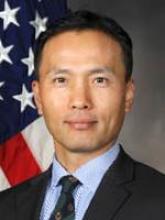Chemical and biological sensor development for human performance and protection
Date & Time:
Fri, 02/12/2021 - 2:00pmSpeaker:
Steve KimAffiliation:
Air Force Research LaboratoryLocation:
ZOOM: Register to be invitedAbstract:
The autonomous and artificial intelligence systems are being spot-lighted for an effective man-machine teaming. In the man-machine teaming loop, the human and their decision making remains detrimental to the success of the team's mission. The precise, noninvasive, and continuous assessment on human cognitive and physiological status not only enhances the efficacy of human decision making, training, authority assignment, and commanding, but also establish a human protection measure by prescriptive treatment or augmentation. Human performance monitoring (HPM) has been emerging as a key element in future biomedical, athletic, and defense area. Human performance monitoring and health protection requires precise monitoring of chemicals and biochemicals. The biomarker detection in physiologically relevant media, such as sweat, saliva, and exhaled breath faces significant challenges ranging from chemical interference to environmental extremity. This presentation will provide an in-depth look on the factors governing in the biomarker sensor development. Specific attention will be given to the bio recognition element (BRE) design, biotic-abiotic interface, surface BRE packing density, and the electronic/electrochemical detection mode to mitigate the challenges in the sensor development.

Biography:
Dr. Steve Kim serves as a Research Physical Scientist and a Program Manager within the Airman Biosciences Division at the 711th Human Performance Wing, Air Force Research Laboratory (AFRL) Wright-Patterson AFB, OH. Dr. Kim obtained his Ph.D. degree in Polymer Science from the University of Connecticut (2007). After completing National Research Council Postdoctoral Fellow (2007-2010), Dr. Kim continued to work as a contract research scientist at AFRL (2010-2016). Dr. Kim's research interest is developing electronic / electrochemical / optical molecular biomarker and chemical sensors for human performance monitoring and force health protection. Dr. Kim leads research on developing an electronic biosensor platform for trace level cognitive molecular biomarkers, a crucial piece of information to increase the human performance monitoring / assessment capability for the United States Air Force (USAF). Dr. Kim's work focuses on bioreceptors and device platforms that enable miniaturization and wearable electronic and electrochemical biomarker sensing. His pioneering nano material study and analytical strategy have unveiled the governing factors in the Nano-Bio interface. Dr. Kim's current research on volatile organic compound gas sensor development revealed that the nanotube electronic sensor outperforms commercial off the shelf products by integrating an innovative biomimetic chemical receptor for low parts per million (ppm) to sub-ppm level gas target in near zero humidity environment, an equivalency to inhaled air in a high altitude fighter jet. Dr. Kim has authored and coauthored 52 peer-reviewed scientific journal articles including his main-authored AFRL works that were recognized as a “Top20 most read article on the web in a year” and a “Top20 most read article on the web in a month” in a high impact journal, Nano Letters.
Seminar ID:
202102121400Department:
Materials Science and Engineering